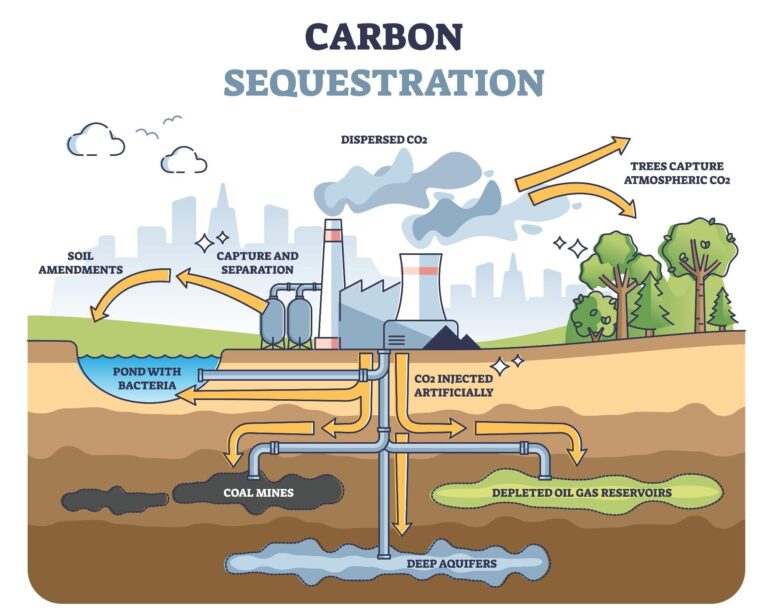As India races toward its ambitious net-zero emissions target, innovative solutions are emerging to tackle the nation’s carbon footprint. Among these, ocean-based carbon capture technologies are gaining attention for their vast potential to absorb and sequester atmospheric COâ‚‚. The recent report “Oceans of Opportunity: Carbon Capture for Net-Zero India,” published by ORFOnline.org, explores how leveraging India’s extensive coastal and marine ecosystems could play a pivotal role in the country’s climate strategy. This article delves into the promising intersections of marine science, policy, and technology that could help India harness its oceans as a critical ally in the fight against climate change.
Oceans as a Frontier for Carbon Capture Innovations in India
India’s extensive coastline and rich marine biodiversity position its oceans as a pivotal arena for pioneering carbon capture technologies. Researchers and startups alike are exploring innovative approaches such as ocean alkalinity enhancement, which involves increasing the ocean’s natural capacity to absorb CO2. Additionally, blue carbon ecosystems-mangroves, seagrasses, and salt marshes-are gaining attention for their unparalleled ability to sequester carbon, making their conservation and restoration vital components of India’s climate strategy. These efforts are complementing traditional carbon capture methods, amplifying the potential for scalable and sustainable carbon reduction solutions.
Key areas driving ocean-based carbon capture initiatives in India include:
- Deployment of carbon mineralization techniques through marine sediments
- Development of algae farming for biosequestration and biofuel synthesis
- Integration of ocean energy systems with carbon capture infrastructure
- Collaborative pilot projects between government agencies, academia, and industry
| Innovation | Carbon Capture Potential (MtCO2/year) | Current Stage |
|---|---|---|
| Blue Carbon Ecosystem Restoration | 15 | Field Trials |
| Marine Mineralization | 8 | Research & Development |
| Algal Biosequestration | 12 | Pilot |
| Ocean Energy-CC Integration | 5 | Conceptual |
Unlocking the Potential of Blue Carbon Ecosystems for Net Zero Goals
Blue carbon ecosystems, encompassing coastal wetlands, mangroves, seagrasses, and salt marshes, stand as nature’s most efficient carbon sinks. Their remarkable ability to sequester carbon at rates up to four times that of terrestrial forests makes them indispensable in the race toward achieving net-zero emissions. Beyond carbon capture, these habitats provide critical services such as coastline protection, biodiversity support, and livelihoods for millions of coastal communities. However, degradation and loss of these ecosystems-driven by urbanization, pollution, and climate change-threaten to reverse these benefits, underscoring the urgent need for concerted conservation efforts.
Strategically integrating blue carbon into India’s climate policies could herald a paradigm shift. With over 7,500 km of coastline, India possesses vast untapped potential in these natural reservoirs. Effective restoration and sustainable management initiatives offer multiple win-win outcomes:
- Enhancement of carbon sequestration capacity
- Strengthened resilience against storm surges and sea-level rise
- Support for fisheries and coastal livelihoods
- Promotion of indigenous knowledge and community-led stewardship
| Ecosystem | Annual Carbon Sequestration (tonnes CO2/ha) | Current Coverage in India (ha) |
|---|---|---|
| Mangroves | 6 – 8 | 4,900,000 |
| Seagrass Beds | 3 – 5 | 5,000 |
| Salt Marshes | 2 – 6 | 12,000 |
Policy Roadmap and Strategic Investments to Scale Ocean-Based Carbon Solutions
A robust policy framework is essential to unlock the full potential of ocean-based carbon capture technologies in India’s quest for net-zero emissions. Strategic investments must prioritize the integration of blue carbon ecosystems-such as mangroves, seagrasses, and salt marshes-into national climate action plans. By incentivizing sustainable fisheries, protecting coastal wetlands, and supporting marine renewable energy projects, policymakers can create a synergistic environment that promotes carbon sequestration while enhancing marine biodiversity. Public-private partnerships will be crucial in driving innovation and scaling pilot projects to commercial viability, enabling a dynamic ecosystem where technology and conservation efforts mutually reinforce each other.
Scaling these solutions demands a multifaceted approach that includes targeted funding, regulatory clarity, and capacity building at community levels. Below is a snapshot of key focus areas for strategic investments:
- Research & Development: Advancing carbon capture efficiency in marine environments
- Coastal Restoration: Expanding vulnerable blue carbon habitats through restoration projects
- Monitoring & Reporting: Implementing sophisticated ocean carbon tracking systems using satellite and AI tools
- Community Engagement: Empowering coastal communities for sustainable resource management
| Investment Focus | Expected Impact | Timeframe | ||||||
|---|---|---|---|---|---|---|---|---|
| R&D in Ocean Carbon Tech | Boost carbon capture rates by 30% | 3-5 years | ||||||
| Coastal Habitat Restoration | Restore 5000 hectares of blue It looks like your HTML content was cut off at the end of the last table row. Here’s a cleaned-up, complete HTML snippet based on what you’ve shared, and I’ll help finish the table row and ensure consistency:
“`html A robust policy framework is essential to unlock the full potential of ocean-based carbon capture technologies in India’s quest for net-zero emissions. Strategic investments must prioritize the integration of blue carbon ecosystems-such as mangroves, seagrasses, and salt marshes-into national climate action plans. By incentivizing sustainable fisheries, protecting coastal wetlands, and supporting marine renewable energy projects, policymakers can create a synergistic environment that promotes carbon sequestration while enhancing marine biodiversity. Public-private partnerships will be crucial in driving innovation and scaling pilot projects to commercial viability, enabling a dynamic ecosystem where technology and conservation efforts mutually reinforce each other. Scaling these solutions demands a multifaceted approach that includes targeted funding, regulatory clarity, and capacity building at community levels. Below is a snapshot of key focus areas for strategic investments:
|




